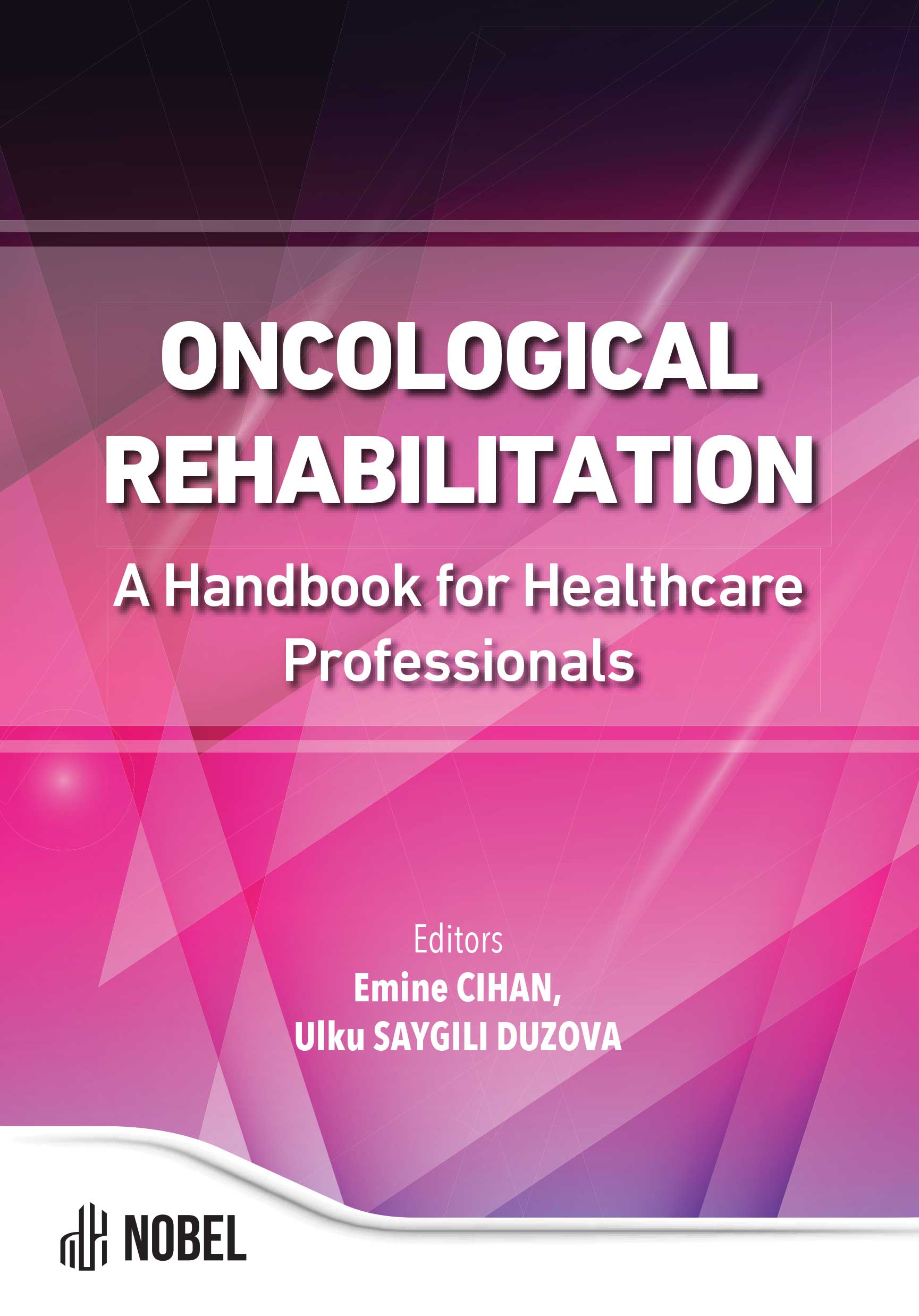Wound Care in Cancer Patients
Mustafa Kilic (Author)
Release Date: 2024-03-07
Cancer treatment can cause various skin and mucosa injuries. These injuries, which seriously reduce the quality of life of patients, should be well identified, evaluated, treated and necessary protective measures taken by healthcare professionals. Having a standardized wound assessment tool ensures consistent and accurate transfer of information among healthcare providers. To provide infection control, it [...]
Media Type
PDF
Buy from
Price may vary by retailers
| Work Type | Book Chapter |
|---|---|
| Published in | Oncological Rehabilitation a Handbook for Healthcare Professionals |
| First Page | 177 |
| Last Page | 188 |
| DOI | https://doi.org/10.69860/nobel.9786053358893.8 |
| ISBN | 978-605-335-889-3 (PDF) |
| Language | ENG |
| Page Count | 12 |
| Copyright Holder | Nobel Tıp Kitabevleri |
| License | https://nobelpub.com/publish-with-us/copyright-and-licensing |
Mustafa Kilic (Author)
Selcuk University
https://orcid.org/0000-0002-7854-2235
3He completed his bachelor’s degree at Selçuk University. He completed his clinical experience in the orthopedic service. He completed his master’s degree in Internal Medicine Nursing at the same university. He did an internship in Austria for 3 months within the scope of Erasmus internship mobility. His areas of interest include diabetes nursing, oncology nursing, research methods and statistical analysis. He currently works as a research assistant.
Kumar, S., Juresic, E., Barton, M., & Shafiq, J. (2020). Management of skin toxicity during radiation therapy: A review of the evidence. Journal of Medical Radiation Sciences, 67(2), 102- 111.
Deptula, M., Zielinski, J., Wardowska, A., Pikula, M. (2019). Wound healing complications in oncological patients: perspectives for cellular therapy. Postepy Dermatologii i Alergologii, 36(2), 139-146.
Smith, A., & Brown, B. (2019). Standardized wound assessment protocols in clinical practice. International Journal of Nursing Studies, 56(4), 450-460.
Hadi, R., Khan, S., & Patel, S. (2020). Efficacy of different wound cleansing solutions in preventing infection. Journal of Clinical Nursing, 29(7-8), 1234-1242.
Chico, H., Webb, M., & Johnson, A. (2019). Mechanical methods of wound debridement and cleaning: A systematic review. Wound Repair and Regeneration, 27(3), 345-353.
Roberts, C., Adams, P., & Johnson, M. (2020). Infection control measures in wound management: A meta-analysis. Infection Control & Hospital Epidemiology, 41(3), 290-299.
Clark, R., Nguyen, P., & Lee, S. (2017). The role of modern dressings in maintaining optimal moisture balance in wound healing. Advanced Wound Care, 6(2), 110-120
Wong, R. K., Bensadoun, R. J., & Boers-Doets, C. B. (2019). Clinical practice guidelines for the prevention and treatment of acute and late radiation reactions from the MASCC Skin Toxicity Study Group. Supportive Care in Cancer, 27(1), 1-13.
Lacouture, M. E., Reilly, L. M., & Gerami, P. (2018). Hand-foot skin reaction in cancer patients treated with epidermal growth factor receptor inhibitors. Journal of Clinical Oncology, 36(9), 961-967.
Borab, Z., Mirmanesh, M. D., Gantz, M., Cusano, A., & Pu, L. L. (2017). Systematic review of hyperbaric oxygen therapy for the treatment of radiation-induced skin necrosis. Journal of Plastic, Reconstructive & Aesthetic Surgery, 70(4), 529-538.
Hajikarimloo, B., Kavousi, S., Jahromi, G. G., Mehmandoost, M., Oraee-Yazdani, S., & Fahim, F. (2024). Hyperbaric Oxygen Therapy as an Alternative Therapeutic Option for Radiation-Induced Necrosis Following Radiotherapy for Intracranial Pathologies. World Neurosurgery, 186, 51-61.
Jones, T., Smith, R., & Brown, L. (2018). The impact of modern wound care products on healing times. Journal of Wound Care, 27(6), 300-310.
Miller, D., & Hart, J. (2021). The effectiveness of patient education programs in wound care management. Patient Education and Counseling, 104(5), 850-860.
Hymes, S. R., Strom, E. A., & Fife, C. (2016). Radiation dermatitis: clinical presentation, pathophysiology, and treatment. Journal of the American Academy of Dermatology, 54(1), 28-46
Singer, S., Arraras, J. I., Chie, W. C., Fisher, S. E., Galalae, R., Hammerlid, E., ... & Sommer, G. (2021). Challenges and strategies in multidisciplinary cancer care. Cancer, 127(13), 2217- 2225.
Fernandez, E., Morillo, V., Salvador, M., Santafe, A., Beato, I., Rodriguez, M., & Ferrer, C. (2021). Hyperbaric oxygen and radiation therapy: a review. Clinical & Translational Oncology, 23(6), 1047-1053.
| onix_3.0::thoth | Thoth ONIX 3.0 |
|---|---|
| onix_3.0::project_muse | Project MUSE ONIX 3.0 |
| onix_3.0::oapen | OAPEN ONIX 3.0 |
| onix_3.0::jstor | JSTOR ONIX 3.0 |
| onix_3.0::google_books | Google Books ONIX 3.0 |
| onix_3.0::overdrive | OverDrive ONIX 3.0 |
| onix_2.1::ebsco_host | EBSCO Host ONIX 2.1 |
| csv::thoth | Thoth CSV |
| json::thoth | Thoth JSON |
| kbart::oclc | OCLC KBART |
| bibtex::thoth | Thoth BibTeX |
| doideposit::crossref | CrossRef DOI deposit |
| onix_2.1::proquest_ebrary | ProQuest Ebrary ONIX 2.1 |
| marc21record::thoth | Thoth MARC 21 Record |
| marc21markup::thoth | Thoth MARC 21 Markup |
| marc21xml::thoth | Thoth MARC 21 XML |

